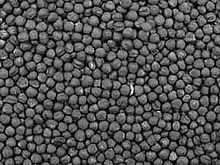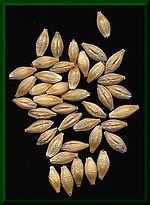Food grain

Grains are small, hard, dry seeds (with or without attached hulls or fruit layers) harvested for human or animal food.[1] Agronomists also call the plants producing such seeds 'grain crops'. Main types of commercial grain crops are cereals such as wheat and rye, and legumes such as beans and soybeans.
Harvested, dry grains have advantages over other staple foods such as the starchy fruits (e.g., plantains, breadfruit) and roots/tubers (e.g., sweet potatoes, cassava, yams) in the ease of storage, handling, and transport. In particular, these qualities have allowed mechanical harvest, transport by rail or ship, long-term storage in grain silos, large-scale milling or pressing, and industrial agriculture, in general. Thus, major commodity exchanges deal in canola, maize, rice, soybeans, wheat, and other grains but not in tubers, vegetables, or many other crops.[2]
Grains and cereals
In botany, grains and cereals are synonymous with caryopses, the fruits of the grass family. In agronomy and commerce, seeds or fruits from other families are called grains if they resemble caryopses. For example, amaranth is sold as "grain amaranth", and amaranth products may be described as "whole grains".[3] The pre-Hispanic civilizations of the Andes had grain-based food systems but, in the higher elevations, none of the grains was a cereal. All three native grains are broad-leaved plants rather than grasses such as corn, rice, and wheat.[4]
Classification
Cereal grains
Cereal crops are all members of the grass family.[5] Cereal grains contain much starch, a carbohydrate that provides dietary energy.
Warm-season (C4) cereals

- finger millet
- fonio
- foxtail millet
- Kodo millet
- Japanese millet
- Job's Tears
- maize (corn)
- pearl millet
- proso millet
- sorghum
Cool-season (C3) cereals
Pseudocereal grains
Starchy grains from broadleaf (dicot) plant families:
- amaranth (Amaranth family)
- buckwheat (Smartweed family)
- quinoa (Amaranth family, formerly classified as Goosefoot family)
Grain legumes or pulses
Members of the (pea family). Pulses have higher protein than most other plant foods. They may also contain starch or oil.
- chickpeas
- common beans
- common peas (garden peas)
- fava beans
- lentils
- lima beans
- lupins
- mung beans
- peanuts
- pigeon peas
- runner beans
- soybeans
Oilseeds
Grains grown primarily for the extraction of their edible oil. Vegetable oils provide dietary energy and some essential fatty acids. They can be used as fuel or lubricants.
Mustard family

- black mustard
- India mustard
- rapeseed (including canola)
Aster family
Other families
- flax seed (Flax family)
- hemp seed (Hemp family)
- poppy seed (Poppy family)
Historical impact of grain agriculture
Grains—being small, hard and dry—can be stored, measured, and transported more readily than other kinds of food crops, such as fresh fruits, roots and tubers. The advent of grain agriculture allowed excess food to be produced and stored easily which could have led to the creation of the first permanent settlements and the division of society into classes.[6]
See also
- Cereals
- Domestication
- Grain drying
- Legume
- List of dried foods
- Perennial grain
- Staple foods
- Vegetable fats and oils
References and Notes
- ↑ Babcock, P.G., ed. 1976. Webster's Third New International Dictionary. Springfield, Massachusetts: G. & C. Merriam Co. .
- ↑ "Agricultural Commodities Products". Cmegroup.com. 2012-07-13. Retrieved 2012-07-19.
- ↑ "Now Vitamins - Now - Organic Amaranth Grain 1 Lb". Totaldiscountvitamins.com. 2011-12-13. Retrieved 2012-07-19.
- ↑ "Lost Crops of the Incas: Little-Known Plants of the Andes with Promise for Worldwide Cultivation". Office of International Affairs, National Academies. Washington D.C.: National Academy Press. 1989. p. 24.
- ↑ Vaughan, J.G., C. Geissler, B. Nicholson, E. Dowle, and E. Rice. 1997. The New Oxford Book of Food Plants. Oxford University Press.
- ↑ Wessel, T. 1984. The Agricultural Foundations of Civilization. Journal of Agriculture and Human Values 1:9-12
| Wikimedia Commons has media related to Food grain. |



